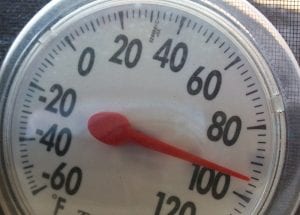With record-high temperatures across the globe, it’s more important than ever to take precautions to stay safe and healthy during excessive heat wave travel.

Death Valley reported its hottest ever midnight temperature at 120°F. The average July temperature in Phoenix was 102.8°F, the hottest month ever for any U.S. city. Throughout July, Miami recorded a heat index above 100°F. Twenty-one U.S. cities set record highs at least once during July.
Outside the U.S., the heat wave in Europe was devastating. China suffered from its own heat wave with temperatures hitting 105.6°F in July. With climate change resulting in global warming expected to continue without abatement in coming years, heat waves will continue to occur and record temperatures will continue to be set.
Despite heat related illnesses being preventable, more than 600 Americans die from extreme heat every year.
According to the CDC (Centers for Disease Control and Prevention) current conditions already cause more than 600 American deaths by extreme heat every year.
Heat related illnesses are serious and preventable. Heat exhaustion, which hits many during heat waves, must be taken seriously. Heat exhaustion can escalate into heat stroke. According to the Mayo Clinic, heat stroke must be treated by a medical professional. “If you suspect heatstroke, call 911 or your local emergency number.”
Travelers must take action to cope and adapt to excessive heat while on their journeys.
Travelers will have to learn to cope and adapt to excessive heat while on their journeys. I have 15 tips for those traveling during heat waves and at locations with excessive heat.
Some are at elevated risk:
Babies, infants and children up to four years of age, seniors, those who are overweight, and those suffering from chronic illness or on some medications are at elevated risk from heat-related illnesses. Planning for their travel in excessive heat is essential.
Hotels and rental cars must have working air conditioning to keep you safe on your journey.
Hotel and rental car air conditioning:
Ensure that your hotel, Airbnb or any rental property in which you’re staying during a heat wave is air conditioned. Window and ceiling fans aren’t enough in excessive heat. While in the U.S., finding accommodations that are air conditioned is typically less of a problem than in Europe and elsewhere, but you should never assume that any location you’re planning to reserve during potential heat waves is air conditioned.
Rental cars:
If you’re reserving a rental car that may be driven during excessive heat, make sure that it’s air conditioned. When you pick it up, carefully check the air conditioning before you drive off. Not long ago, I had to reject two cars at the car rental location at the Louis Armstrong New Orleans International Airport due to air conditioning. One barely worked and the other didn’t work at all.
Get travel insurance:
It’s good to have the option for your trip to be able to call it off if a heat wave hits that makes it unsafe for you to be at your destination(s) or forces you to cut back on your activities so that it’s not worth traveling. Make sure you opt in to the “cancel for any reason” option.
Sunscreen and the right clothing are essential to keep you safe and healthy during periods of excessive heat.
Sunscreen:
In the hot sun, excessive heat isn’t the only problem. UV light from the sun requires protection, too. Pack a broad spectrum sunscreen that filters out both UVA and UVB rays and has an SPF of 15 or higher. If you’re traveling with children under the age of six months, according to the CDC, don’t use sunscreen on them. Instead, keep their skin covered. Typically, sunscreen holds up for about two hours. After that time, reapply it, or after swimming, heavy sweating or toweling off.
Clothing:
Pack clothing made from light colored, cool, breathable fabrics, preferably ones that wick perspiration. Only pack dark colored clothing for evening wear, as dark colors absorb sunlight, heating your body. Pack clothing that is UPF 50+ protection, if at all possible, for your outerwear. In sunny, excessively hot temperatures, don’t forget to protect your head and feet. Pack a wide brimmed UV protective hat and comfortable, lightweight shoes or sneakers.
Plan your outdoor activities carefully during excessive heat and stay inside in air conditioned spaces when necessary.
Time your outdoor activities:
When planning a day of travel that includes outdoor activities, choose wisely. Try to avoid outdoor activities at the hottest times of the day, typically about 11 a.m. through mid-afternoon or so. Instead, plan to be outside during early morning or the evening, if possible. Plan to be inside in air conditioned museums, restaurants, stores, historic locations, etc., during the heat of the day.
During hotter hours, plan cooler activities:
Consider taking a breezy boat ride for a tour of cities like Amsterdam, Bruges or Venice when it’s hot. The breeze during these tours will keep you reasonably cool.
Consider a journey or day trip into the mountains:
Take a break from cities and lowlands during heat waves and travel to the mountains. Take a day trip or stay for a while. Either way, the mountains should give you a break from the heat below. Particularly in Europe, where there are many alpine towns, the respite from heat waves can be a wonderful break.
Hydration is essential during periods of excessive heat, but avoid alcohol and caffeinated beverages.
Hydrate, hydrate, hydrate:
Pack an empty water bottle to fill yourself, as disposable water bottles, if you still use them, may not be available at your destination. I pack a metal insulated water bottle. If you’re concerned about local water quality, bring an electronic UV purifier and a water filter. If you perspire a great deal, you may want to replenish the electrolytes in your body. Bring a few packets of a suitable electrolyte mix for your use, if needed.
Avoid alcohol:
Even when you’re in air conditioned restaurants and taverns during a heat wave, skip the alcoholic beverages. Alcohol is a diuretic. That means it encourages the kidneys to get rid of fluid. Alcohol makes you sweat more. It also reduces the release of ADH in your body. ADH works with your kidneys to keep your body fluids balanced. Simply put, alcohol doesn’t help you stay hydrated. It essentially does the opposite.
Avoid caffeinated beverages:
Caffeinated beverages tend to heighten dehydration. Like alcohol, they’re diuretics.
Drink water and other non-alcohol or caffeinated beverages:
You can’t beat water to stay hydrated. I carry it around everywhere when outside in summer in an insulated water bottle with some ice in it. Some fruit juices will work ,too.
Use shade when outside, to the extent possible.
Use shade when out in the sun:
Walking on the shady side of the street can help during a heat wave. So can detouring through the shade trees in parks along the way, rather than trudging on sunny, heat radiating sidewalks.
Stay tuned:
It’s important to understand what’s going on at your destination(s) before you leave and while you’re there, so make sure you keep up with the news before you leave and at your destination(s). Moreover, sign up for alerts from local government organizations at your destination(s) and from weather information sources.
These days, not taking weather seriously can ruin your vacation. Be on top of weather conditions while planning your journey and continue monitoring it daily until you return home. While on the go, take all appropriate measures to stay safe and healthy, despite conditions.
After many years working in corporate America as a chemical engineer, executive and eventually CFO of a multinational manufacturer, Ned founded a tech consulting company and later restarted NSL Photography, his photography business. Before entering the corporate world, Ned worked as a Public Health Engineer for the Philadelphia Department of Public Health. As a well known corporate, travel and wildlife photographer, Ned travels the world writing about travel and photography, as well as running photography workshops, seminars and photowalks. Visit Ned’s Photography Blog and Galleries.



